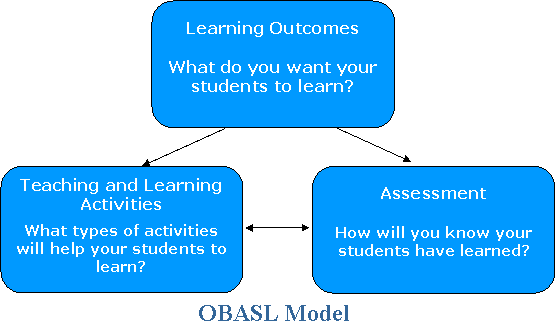
![]()
OBASL & The Relationship with Learning Outcomes, Learning Activities and Assessment
The design of assessment basically defines the curriculum for students, consequently determines students' approach to study, and therefore indirectly determines the quality of their learning. As a result, teachers can make use of assessment as a strategic tool to direct their students to the appropriate studying approaches to achieve the desired learning outcomes in their courses. In addition, assessment should exhibit clear alignments with the intended learning outcomes, as well as the teaching and learning activities, which are considered altogether as the 3 core elements of curriculum design in higher education. Thus, when designing the course, the 3 core elements ' the Intended Learning Outcomes, the Teaching and Learning Activities and the Assessment should be designed interdependently and simultaneously.
Click here to see a sample of the HKU's course outline template pdf version
Click here to see a sample of the HKU's course outline template doc version
Outcomes Based Approach to Student Learning (OBASL)
OBASL is an approach to programme and course design. It clearly focuses on what students are expected to learn and do in terms of statements of Learning Outcomes. It consists of three main elements: Learning Outcomes, Learning Activities and Assessment.

- Learning outcomes are statement or a set of statements that specify what the learners will know and be able to do at the end of the course.
- Learning activities are the teaching and learning methods which the teachers use to achieve each of the Learning Outcomes. Students will know exactly why they are being asked to engage in certain teaching and learning activities in their courses.
- Assessment is an on-going evaluation process aimed at understanding and improving student learning by measuring the learning outcomes the students may have achieved. Students will have a clear idea of why they are being assessed in the way they are. Finally, students will be able to understand what they need to do to get higher grades in their courses.
Constructive Alignment
Constructive Alignment is a learning and teaching principle devised by John B. Biggs. It basically states that the intended learning outcomes, the learning activities and the assessment tasks in a course/programme must be properly aligned. Thus the intended learning outcomes (what do we want the learners to know?) must be supported by the correct use of learning activities (how will the learners learn?) and the assessment tasks including the languages employed (how will we know the learners have learnt?). It is vitally important when we design our course/programme, these three components are careful considered and written to enhance better student learning.